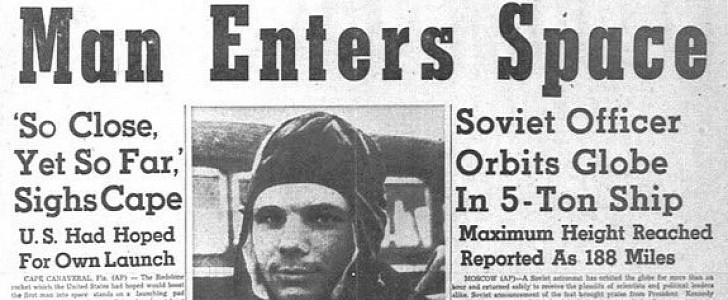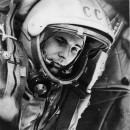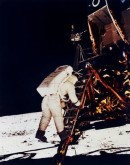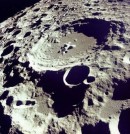Today is a special day – we're celebrating the International Day of Human Spaceflight! It was on April 12, 61 years ago, that Russian cosmonaut Yuri Gagarin carried out the first human space flight, opening a new chapter of human space exploration.
The celestial objects in our skies have always fascinated humans. In the 1990s, the development of rockets, as well as other technological advances, made it possible to send machines, animals, and eventually people into space.
The first human-made machine to make it into outer space was the Sputnik satellite, launched by the Soviet Union on October 4, 1957. The successful launch of the satellite opened the gates to space exploration and sparked the Space Race between the U.S. and the Soviet Union.
Concerned about the Soviet Union's space dominance, NASA launched Project Mercury, the first American man-in-space program. The goal? To send a man into orbit and safely return him to Earth before the Soviets.
But the U.S.S.R. was a step ahead. On April 12, 1961, Yuri Gagarin became the first human to journey into outer space, successfully circling our planet for 108 minutes. The historic flight took place less than a month before astronaut Alan Shepard reached orbit as on May 5, he became the first American to fly in space.
That same year, in the aftermath of the Gagarin flight, President John F. Kennedy "challenged the country to put a man on the moon by the end of the decade." After multiple failed launch attempts, it became evident that the U.S.S.R. would not reach the Moon before the U.S.
So eight years later, after President Kennedy set the national goal of landing on the satellite, the Apollo 11 astronauts Neil Armstrong and Buzz Aldrin put their boots onto the surface of the Moon for the first time. The U.S. followed with five other Apollo crewed missions to the Moon.
The last manned mission was Apollo 17 took place in 1972 – the same year when the competition between the U.S. and the Soviet Union started to become a collaboration. In 1975, the two carried out the Apollo-Soyuz Test Project – the mission that ended the Space Race and kicked off a new era of international collaboration beyond our skies.
The Apollo-Soyuz mission also laid the foundation for other collaborative space efforts, including the Shuttle-Mir and the International Space Station (ISS) programs. Soon after, several international partners joined to fulfill the humans' dream of reaching other worlds.
So in the memory of the man who became the first person to go into space, we should celebrate humanity's achievements, not war. In 1961, after returning back to Earth, Yuri Gagarin said: "Orbiting Earth in the spaceship, I saw how beautiful our planet is. People, let us preserve and increase this beauty, not destroy it!"
The first human-made machine to make it into outer space was the Sputnik satellite, launched by the Soviet Union on October 4, 1957. The successful launch of the satellite opened the gates to space exploration and sparked the Space Race between the U.S. and the Soviet Union.
Concerned about the Soviet Union's space dominance, NASA launched Project Mercury, the first American man-in-space program. The goal? To send a man into orbit and safely return him to Earth before the Soviets.
But the U.S.S.R. was a step ahead. On April 12, 1961, Yuri Gagarin became the first human to journey into outer space, successfully circling our planet for 108 minutes. The historic flight took place less than a month before astronaut Alan Shepard reached orbit as on May 5, he became the first American to fly in space.
That same year, in the aftermath of the Gagarin flight, President John F. Kennedy "challenged the country to put a man on the moon by the end of the decade." After multiple failed launch attempts, it became evident that the U.S.S.R. would not reach the Moon before the U.S.
So eight years later, after President Kennedy set the national goal of landing on the satellite, the Apollo 11 astronauts Neil Armstrong and Buzz Aldrin put their boots onto the surface of the Moon for the first time. The U.S. followed with five other Apollo crewed missions to the Moon.
The last manned mission was Apollo 17 took place in 1972 – the same year when the competition between the U.S. and the Soviet Union started to become a collaboration. In 1975, the two carried out the Apollo-Soyuz Test Project – the mission that ended the Space Race and kicked off a new era of international collaboration beyond our skies.
The Apollo-Soyuz mission also laid the foundation for other collaborative space efforts, including the Shuttle-Mir and the International Space Station (ISS) programs. Soon after, several international partners joined to fulfill the humans' dream of reaching other worlds.
So in the memory of the man who became the first person to go into space, we should celebrate humanity's achievements, not war. In 1961, after returning back to Earth, Yuri Gagarin said: "Orbiting Earth in the spaceship, I saw how beautiful our planet is. People, let us preserve and increase this beauty, not destroy it!"






